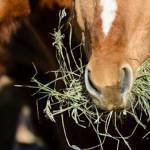A Weighty Subject: The Horse’s Digestive Tract

To understand how the digestive system can influence exercise performance, one must first appreciate the size and weight of the equine digestive system.
Horses have developed a specialized digestive system that allows them to thrive on high-fiber diets. The horse’s small single-compartment stomach makes up less than 7% of the empty weight of the digestive system and explains the need for a continual intake of feedstuffs.
The cecum and colon collectively account for approximately 64% of the empty weight of the horse’s digestive system. These two structures, known as the hindgut, are estimated to hold between 24 and 36 gallons (90 to 135 liters) of liquid and house billions of bacteria and protozoa that ferment plant fiber.
The small intestine is the single longest and heaviest structure in the horse’s digestive system, making up 27.5% of the total gastrointestinal tract weight. The empty tissue weight of the stomach, small intestine, and large, fiber-fermenting hindgut accounts for approximately 5% of the body weight of the mature horse. Considering that a fed (non-fasted) horse has a fluid capacity within the digestive system of nearly 50 gallons (190 liters), a much larger percentage of the horse’s body weight is associated with the digestive system. This can be appreciated when one considers that a partial fast (24 hours) can result in a 3.5% decrease in body weight for mature physically conditioned ponies.
Eating has the obvious result of increasing the amount of material in the digestive system. This has a profound impact on the body weight of the animal. For every kilogram of dry hay intake, approximately 10 kg (22 lb) of water is ingested. Eating hay stimulates saliva production and an increase in the secretion of digestive juices into the gastrointestinal tract. Much of the fluid in these secretions comes from blood plasma, resulting in a drop in plasma volume. Decreased plasma volume then stimulates a thirst response and horses drink water. Fiber also has the capacity to bind water in the digestive system. This facilitates the holding of water in the hindgut as the amount of fiber in the diet increases. The amount of water ingested with mixed diets (forage and concentrate) is roughly half that of all-forage diets.
With changes in fluid content of the gut being a characteristic of different feeds, the type of diet fed to performance horses can have an impact on body weight during exercise. This can be illustrated by calculating the energy requirement for a given performance horse, then calculating the amount of feed necessary to satisfy this requirement.
The amount of feed necessary to maintain energy balance in a performance horse being fed either a 100% forage diet, a 50% forage plus 50% oat diet, or a 45% forage/45% oat/10% vegetable oil diet would be different due to the increased energy content of the mixed diets. For comparison, a performance horse would need to consume 22.2 kg (49 lb) of forage; or 16.6 kg (37 lb) of mixed feed; or 12.9 kg (28 lb) of mixed feed plus vegetable oil to maintain body weight. The fat-supplemented diet would reduce feed intake by 22%, fecal output (gut fill) by 31%, and water requirement by 12%.
Similarly, a study done by Kentucky Equine Research (KER) showed that performance horses working at moderate intensity consumed 10% more feed when fed an all-forage diet compared with a mixed forage and grain diet. Further, the horses on the all-forage diet consumed 33% more water than horses eating the mixed diet. To summarize these research reports, it appears the higher the fiber content of the diet, the greater the fluid content of the digestive system and the more weight carried by the horse.
What does all of this mean for horse owners? Simply put, the less a horse weighs after being fed, the better it can perform, all other things being equal. Therefore, the type and amount of feed and hay need to be chosen in relation to the work the horse will be asked to do. For example, racehorses will probably perform best if hay has been restricted for several hours before the race, while endurance horses that are ridden more slowly for longer periods will benefit from the fluid reservoir contained in a gut full of hay.








